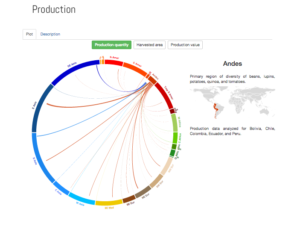“Worldwide Evaluation of Quinoa: Preliminary Results from Post International Year of Quinoa FAO Projects in 9 Countries.” The title sounded promising enough. At last, something scientifically worthwhile emerging from one of those international years. Nineteen sites, 21 genotypes, a few winners: well worth having.
But have a look at the materials part of the materials and methods section. Read it and weep.
Due to the difficulties to access quinoa germplasm at global level, each country made specific requests through its networks. FAO has mobilized various partnerships to collect different quinoa accessions to carry out the study. First, through a collaboration with the International Center for Biosaline Agriculture (ICBA, a non-profit International Organization) — a research center based in the United Arab Emirates (UAE) — FAO could access specific varieties of quinoa. Seeds of the three varieties under development (Q1, Q2 and Q3) were obtained from ICBA to be made available for the trials in Yemen. FAO has also received seeds from the Centro di Ricerca per la Cerealicoltura (CRA-CER) in Italy which helped to expand the genotypes proposed in the tests. The seeds of nine accessions of landraces (Q12 to Q31) were obtained from CRA-CER who has been working and selecting these accessions in Italy after accessing them from the United States Department of Agriculture genebanks (USDA). These seeds had Chilean origin. Seeds were supplied to FAO-RNE which has distributed them to eight countries in the region. The two quinoa varieties (Sajama and Santamaria) were provided by PROINPA in Bolivia to the Seed & Plant Improvement Institute (SPII) in Iran. Selected seeds of early matured plants from the genotype “Sajama” have produced a new variety that was called “Iranshahr”. Giza1 and Giza2 have been selected in Egypt from preliminary quinoa lines furnished by the University of Copenhagen in Denmark. Finally, Puno and Titicaca are two varieties of the Quinoa Quality Enterprise linked to the University of Copenhagen (Denmark). Regalona is the only quinoa variety with PVP developed by Von Baer Seeds for the Southern part of Chile (Von Baer et al, 2009). Finally, each country could choose from over 21 fairly differentiated genotypes.
The Food and Agriculture Organization of the United Nations, no less, tries to put together an international multilocational quinoa evaluation trial during the International Year of Quinoa, no less, and it has to go through all these hoops, and in the end this is the best it can do in terms of putting together a diverse set of landrace and improved germplasm for testing? There may be up to 3000 quinoa varieties out there, and 15,000 accessions in genebanks.
It’s better than nothing, you’ll say. And you’d be right. But still. It does make you grateful for the International Treaty on PGRFA. Quinoa is not on Annex 1 of the Treaty, so not covered by the “facilitated access” that would presumably have made the assembling of an international collection of asparagus, say, a bit easier. And it also make you grateful for global collections, such as those managed by the CGIAR centres under Article 15 of the Treaty. All the transaction costs implied by that paragraph above — not to mention the heartache — magically disappear. Well, most of them anyway.

LATER: I guess a lot of this could be discussed later this year in Dubai… I wonder if there will be a call for inclusion of quinoa in Annex 1?